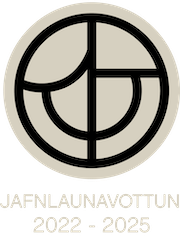Megindlegt mat á staðbundnum mögnunaráhrifum íslenskra jarðlaga í jarðskjálftum - verkefni lokið
Fréttatilkynning verkefnisstjóra
Staðbundin mögnunaráhrif mjúkra jarðlaga á jarðskjálftabylgjur þekkjast víða um heim þar sem þau valda auknum líkum á skemmdum á mannvirkjum í jarðskjálftum. Því er æskilegast að jarðlögin séu úr sem hörðustu efni (t.d bergi) því þá eru slík staðbundin áhrif í lágmarki. Hvað jarðskjálftahönnum á Íslandi varðar er ekki gerður greinarmunur á gömlum berglögum eða ungum hraunlögum á yfirborði.
Nýjar rannsóknir á mælingum á jarðskjálftum og jarðsuði á yfirborði ólíkra jarðlaga s.s. þar sem hraunlög liggja ofan á mýkri jarðlögum sýna hins vegar að talsverður munur er á staðbundnum áhrifum á nýlegum hraunum en á gömlu bergi. Þar sem slíkar upplýsingar eru mikilvægar í jarðskjálftahönnun mannvirkja hafa nýjar megindlegar greiningaraðferðir verið notaðar á jarðskjálfta- og jarðsuðsmælingar til að meta eiginleika slíkra jarðlaga, og annarra algengra jarðlaga á Íslandi. Lögð var sérstök áhersla á að nota eðlisfræðileg líkön og að ákvarða óvissu stika þeirra með Bayesískum aðferðum. Þannig hafa fengist ný hraðalíkön af efstu jarðlögunum sem nota má gagngert til þess að herma staðbundin bylgjumögnunaráhrif þar sem áreiðanleiki þeirra er þekktur, en slíkt er forsenda bætts mats á jarðskjálftavá, áhættu af völdum jarðskjálfta, byggðarskipulags og jarðskjálftahönnunar mannvirkja og mikilvægra innviða nútíma samfélags.
English:
The geological condition known as “Rock” is desirable in aseismic design due to the low seismic wave amplification, known as “site-effects”, that is expected on hard geological material. In Iceland, the rock site characterization for earthquake engineering applications is common due to the easily exposed older bedrock or recent volcanic lava-rock. Consequently, the corresponding site amplification is generally assumed to be low and the spatial distribution of ground motion amplification is expected to be uniform. However, recent site-effect studies in Iceland using earthquake ground motions on different site conditions such as alternating layers of lava-rock or soft sediments have shown markedly different site-effects than on firm older bedrock which may have important practical implications for seismic design. In this proposal therefore, a comprehensive, reliable, and environmentally friendly framework based on recording and analysis of seismic ground motion data set was developed to estimate the subsoil structure that controls seismic wave amplification. These parameters are generally referred to as the “velocity profile” was derived using ground motion data using physical models and Bayesian statistical methods. Moreover, a novel statistical tool was developed to investigate the spatial distribution of ground motion amplitudes. Such information is a key element for site classification guidelines, seismic design criteria, microzonation studies, and seismic hazard analysis.
List of publications:
- Kennedy T.J., Halldorsson B., Snæbjörnsson J.Þ., and Green R.A. (2019) “Influence of gravel fill on the seismic response characteristics of sites in Iceland”. In: Proceedings of the XVII European Conference on Soil Mechanics and Geotechnical Engineering. Reykjavik, Iceland, 1- 6 September 2019, 7p. (Paper and presentation)
- Kennedy T. J., Halldorsson B., Snæbjörnsson J. Þ., Green, R. A., and Rahpeyma S. (2019) “Microseismic response characteristics of typical gravel fills in Iceland using HVSR and SSR techniques”. In: Proceedings of the 3rd International Workshop on Earthquake Engineering in North Iceland, Húsavík, 21-24 May 2019. (Extended abstract and presentation)
- Rahpeyma, S., Halldórsson, B., Hrafnkelsson, B., Green, R. A., Jónsson, S., and Polat, O. (2021) ‘‘Bayesian inference of shear-wave velocity profiles using the body-wave approximation of H/V Spectral Ratio from Microseismic recordings in Layered media” (manuscript ready for submission)
- Rahpeyma S., Halldorsson B., and Hrafnkelsson B. (2020) “Velocity Profile Estimation In The Presence Of Multiple Strong Velocity Reversals” 17th World Conference on Earthquake Engineering(17WCEE), 13-18 September 2020, Sendai, Japan, paper no. 3950.
- Rahpeyma S., Kennedy T. J., Halldorsson B., Hrafnkelsson B., Green, R. A., and Snæbjörnsson J. Þ. (2019) “On the Microseismic Response of Lava Layers as Road and Bridge Foundations” Vegagerðin Annual Meeting, 01 November 2019, Reykjavik, Iceland (Poster)
- Rahpeyma, S., Halldórsson, B., Hrafnkelsson, B., Green, R. A., and Jónsson, S (2021) ‘‘Frequency dependent site factors for the Icelandic strong-motion array from a Bayesian hierarchical model of the spatial distribution of spectral accelerations” (in review by Earthquake Spectra)
- Rahpeyma, S., Halldórsson, B., and Hrafnkelsson, B. (2021) ‘‘Frequency-dependent Site Factors of Icelandic Strong-Motion Stations Derived using Multi-level Bayesian Ground Motion Modelling” (in review by coauthors)
- Rahpeyma, S., Kowsari, M., Sonnemann, T., Halldórsson, B., and Hrafnkelsson, B. (2021) ‘‘Statistical Modelling of Earthquake Engineering Data" Chapter 5, Springer International Publication Switzerland, Handbook of Physical statistical modeling using latent Gaussian models” (in review by coauthors)
- Rahpeyma, S., Halldórsson, B., Hrafnkelsson, B. (2021) ‘‘Detailed site effect estimation using multi[1]level modeling of earthquake strong-motion amplitudes and uncertainties” 6th International Conference on Geotechnical and Geophysical Site Characterization, 7-11, September, Budapest. (Accepted paper)
- Rahpeyma S., Halldorsson B., Hrafnkelsson B., Jónsson S. (2019) “Site Effect Estimation on two Icelandic Strong-motion Arrays Using a Bayesian Multi-level Model for the Spatial Distribution of Earthquake Ground Motion Amplitudes” Proceedings of the 3rd international workshop on earthquakes in North Iceland, 22-24 May 2019, Húsavík, Iceland. (Extended abstract and presentation)
- Rahpeyma S., Darzi A., Halldorsson B. (2021) “Site effect characterization of the Icelandic strong[1]motion network from the earthquake and microseismic recordings” (manuscript in preparation)
Heiti
verkefnis: Megindlegt
mat á staðbundnum mögnunaráhrifum íslenskra jarðlaga í jarðskjálftum / Comprehensive
analysis and modeling of seismic wave amplification for Icelandic site
Verkefnisstjóri: Saharalsadat Rahpeyma,
Háskóla Íslands
Tegund styrks: Nýdoktorsstyrkur
Styrktímabil: 2019-2020
Fjárhæð styrks: 19,895 millj. kr. alls
Tilvísunarnúmer Rannís:
196407


